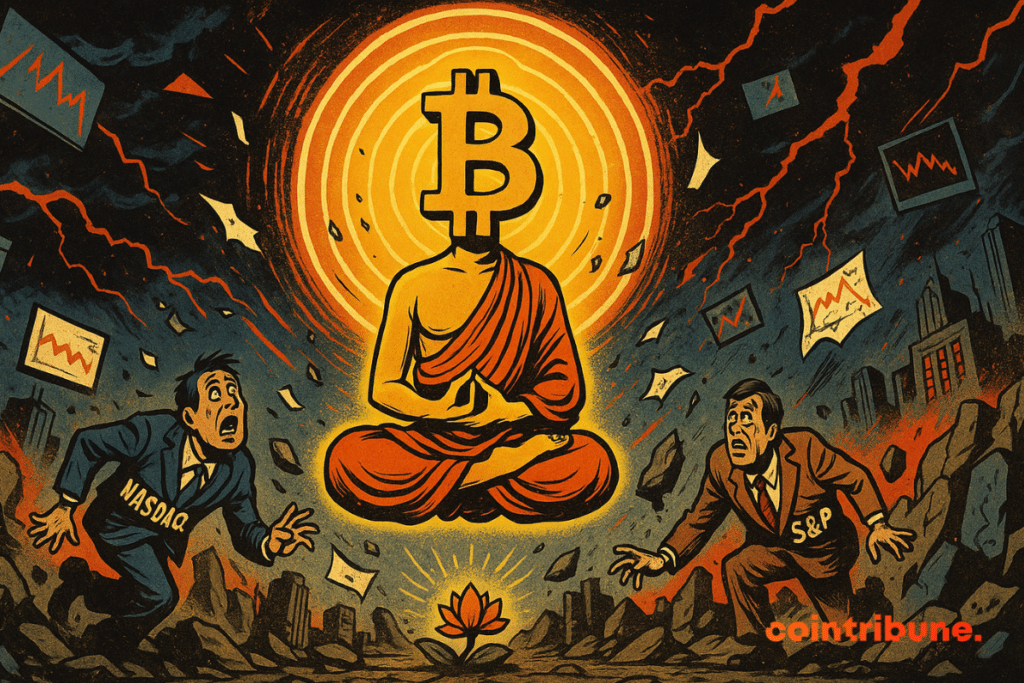8h05 ▪
4
min read ▪ by
In a crypto market where volatility is the norm, Bitcoin has just crossed an unexpected threshold. It is now less volatile than the S&P 500 and the Nasdaq. This subtle but significant shift, revealed by Galaxy Digital, challenges a decade of perception of an asset deemed too risky for traditional portfolios. More than a simple technical indicator, this signal could mark a lasting change in status for the first cryptocurrency.


In Brief
- Bitcoin now shows lower volatility than the S&P 500 and Nasdaq, according to Galaxy Digital, an unprecedented situation for an asset long considered unstable.
- Key indicators such as the Bloomberg Dollar Index and gold have experienced significant fluctuations, reinforcing the perception of Bitcoin as a counter-asset in crises.
- The inflow of institutional capital, notably via ETFs, contributes to this stabilization, supported by prudent risk management in crypto markets.
- With 95 % of Bitcoin supply already in circulation, scarcity strengthens its image as a digital safe haven, comparable to gold in a world of monetary restructuring.
Volatility Increasingly Comparable to Traditional Assets
On May 12, Galaxy Digital revealed that Bitcoin’s 10-day realized volatility had fallen to 43.86, a level now lower than the S&P 500 (47.29) and Nasdaq 100 (51.26). This is considered an exceptional situation for a historically unstable asset.
Analysts note in their report :
An unusual position for a crypto historically known for its excessive volatility.
This shift comes as traditional markets show signs of fragility, especially since Donald Trump’s surprise announcement on April 2 regarding the “tariff liberation day”, which amplified international economic tensions.
In this context, Bitcoin has not only stabilized but has risen by 11 % over the period, sharply contrasting with the stagnation of stock indices. Several major economic indicators, meanwhile, have experienced increased volatility :
- The Nasdaq Composite remained almost stable despite the turbulence ;
- The Bloomberg Dollar Index dropped nearly 4 % ;
- Gold briefly crossed the symbolic threshold of $3,500 an ounce before pulling back 5.75 %.
Galaxy Digital compares this situation to that observed in 2018–2019 during trade tensions between the United States and China, a period during which Bitcoin had already established itself as a safe-haven asset.
This parallel highlights an emerging dynamic. In phases of systemic crisis, Bitcoin tends to behave as a macroeconomic counter-asset, a role until now reserved for commodities such as gold.
The Growing Influence of Institutional Players in Bitcoin Stabilization
Beyond recent fluctuations, Galaxy Digital identifies a deeper trend: the decline of Bitcoin’s beta relative to major indices, despite still high 30-day correlations with the S&P (0.62) and Nasdaq (0.64).
This risk profile change indicates that “investors are beginning to see Bitcoin less as a high-risk asset and more as a long-term allocation”, comments Chris Rhine, Head of Liquid Strategies at Galaxy.
In other words, Bitcoin would be moving out of the speculative assets category to join the sustainable portfolio components.
This evolution is also supported by the rise of institutional liquidity. Hank Huang, CEO of Kronos Research, notes that ongoing inflows towards ETFs and recurring strategic Bitcoin purchases “help transform it into a digital version of gold, less correlated with equities”.
This stabilization is made possible, according to Galaxy, by a market “tactically cautious but structurally constructive”, characterized by disciplined leverage usage and low pressure on hedging strategies. With 95% of total Bitcoin supply already mined, the asset’s mechanical scarcity reinforces this maturity dynamic.
This transformation could ultimately reshape the landscape of international reserves. On April 25, Jay Jacobs, Head of Thematic ETFs at BlackRock, noted that states are gradually reducing their dependence on the dollar to turn to alternative assets such as gold… and now Bitcoin. “Geopolitical fragmentation fuels demand for uncorrelated assets”, he explained, explicitly mentioning Bitcoin’s growing role as a safe haven alongside the precious metal.
Maximize your Cointribune experience with our “Read to Earn” program! For every article you read, earn points and access exclusive rewards. Sign up now and start earning benefits.
Diplômé de Sciences Po Toulouse et titulaire d’une certification consultant blockchain délivrée par Alyra, j’ai rejoint l’aventure Cointribune en 2019.
Convaincu du potentiel de la blockchain pour transformer de nombreux secteurs de l’économie, j’ai pris l’engagement de sensibiliser et d’informer le grand public sur cet écosystème en constante évolution. Mon objectif est de permettre à chacun de mieux comprendre la blockchain et de saisir les opportunités qu’elle offre. Je m’efforce chaque jour de fournir une analyse objective de l’actualité, de décrypter les tendances du marché, de relayer les dernières innovations technologiques et de mettre en perspective les enjeux économiques et sociétaux de cette révolution en marche.
DISCLAIMER
The views, thoughts, and opinions expressed in this article belong solely to the author, and should not be taken as investment advice. Do your own research before taking any investment decisions.

